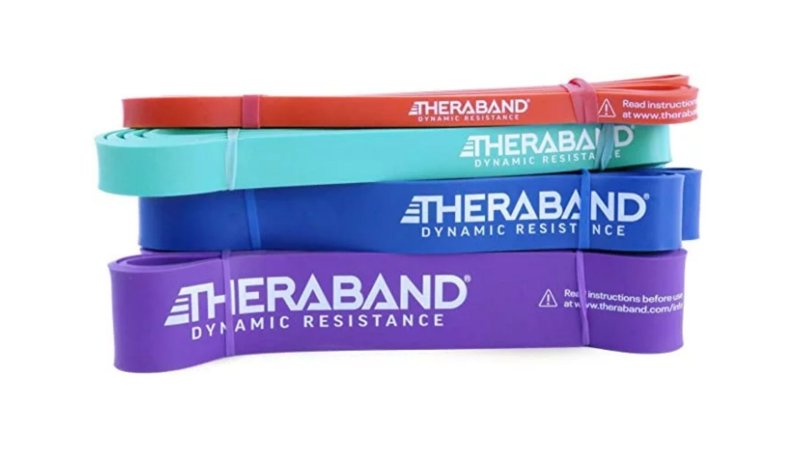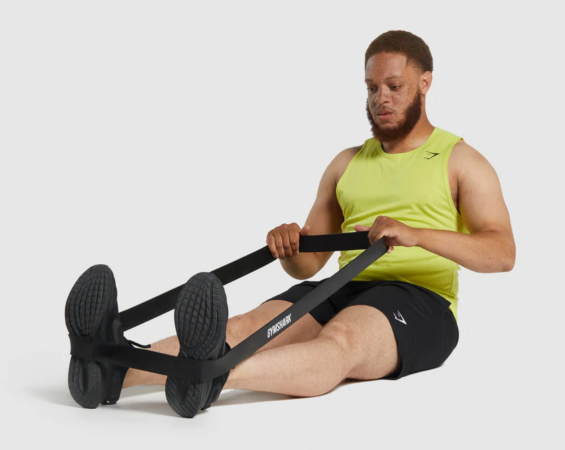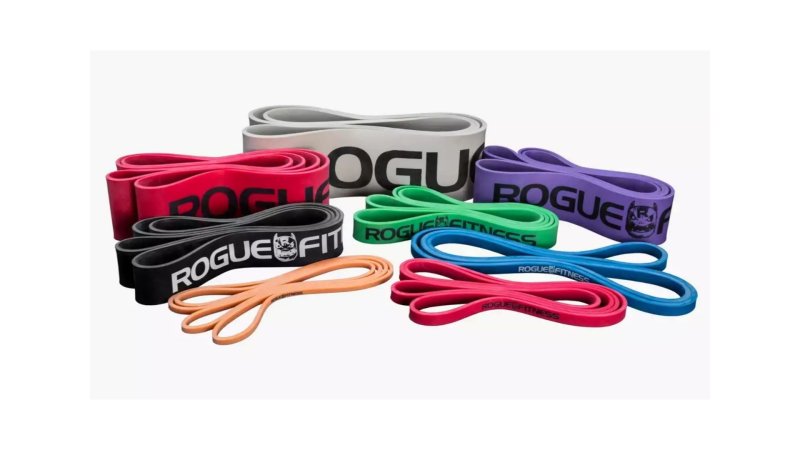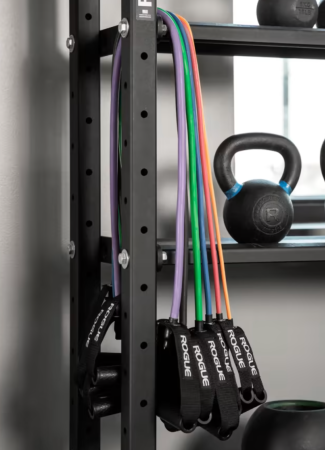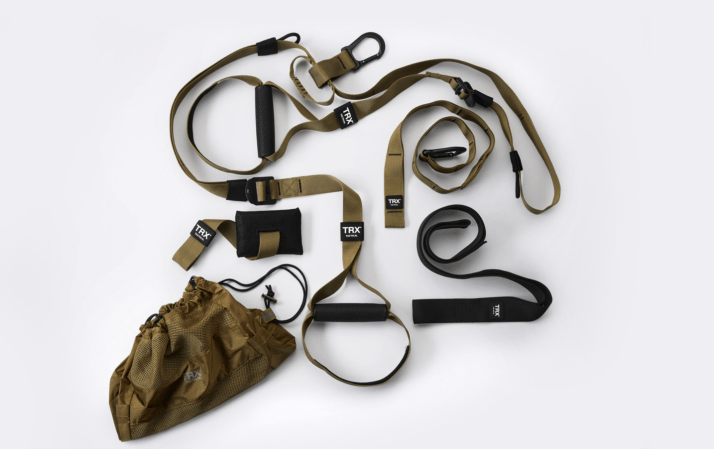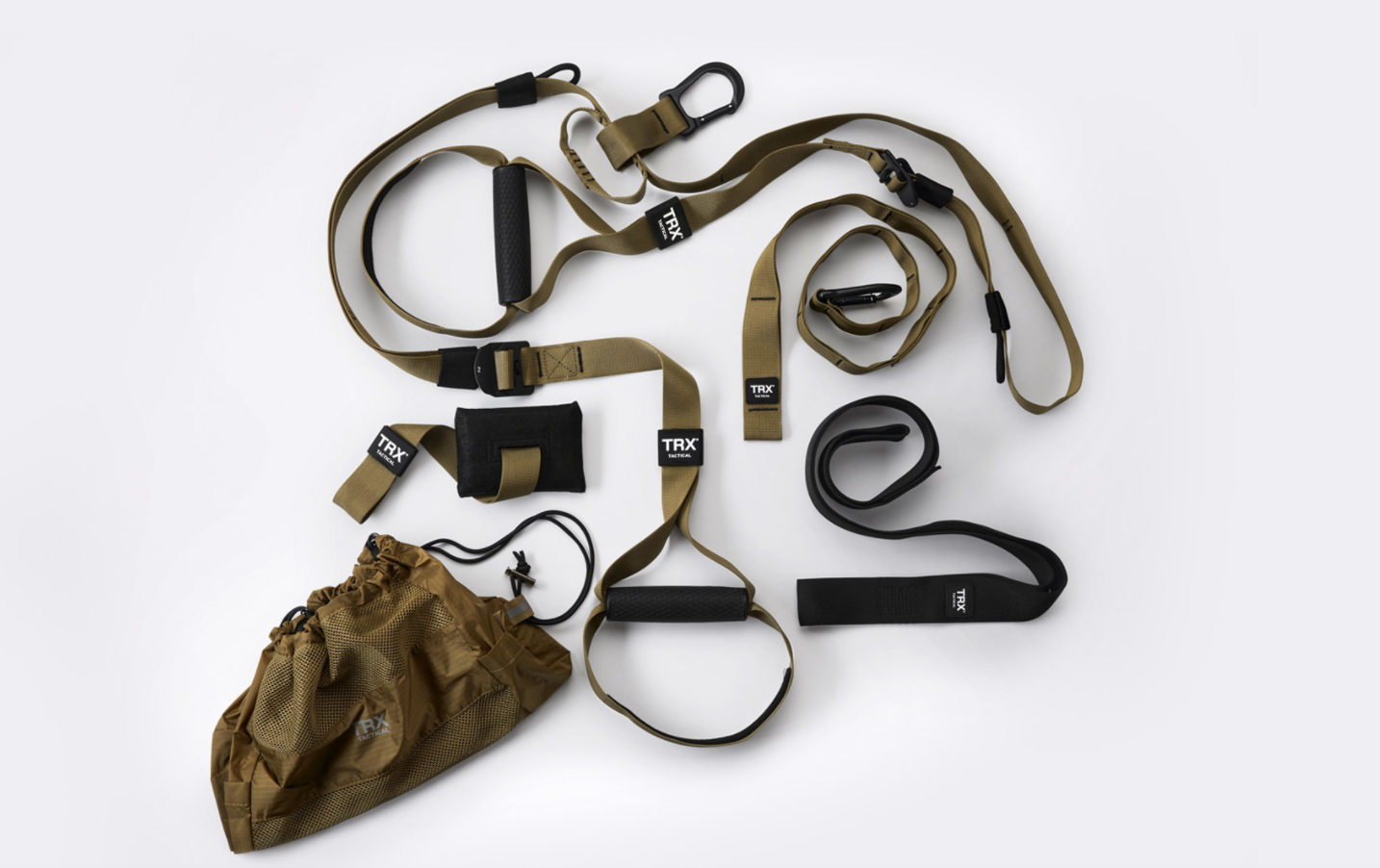

We may earn revenue from the products available on this page and participate in affiliate programs.
If your gym bag isn’t equipped with a set of resistance bands, you should probably fix that sooner than later. The stretchy fitness accessory seems too simple and inexpensive to make a difference, but looks can be deceiving.
In early 2020, I was lucky enough to work out at one of the best gyms I’ve ever seen. It had rows of squat racks, two monolifts, about a dozen deadlift platforms, endless dumbbells, and strongman equipment most people have never even heard of. There were separate rooms full of strength training and cardio equipment. And the speakers played heavy metal nonstop. Then lockdowns hit.
I found myself working out at home with dumbbells up to 25 pounds, a few resistance bands, and an endlessly patient wife who let me fireman-carry her on leg day. That period of time made me a big believer in resistance bands. A few glorified rubber bands allowed me to train every muscle group and stay in shape until the gyms reopened. Now, they’ve earned a spot in my active recovery routine and travel with me when I need to stay fit on the road.
Understanding resistance bands is easy, but there are some key basics you need to know. That’s why we did the leg work for you, and the result is a shortlist of recommendations that can have an oversized impact on your fitness.
Best Overall
TheraBand High-Resistance Bands
Pros
- Build quality trusted by professionals
- Large enough for full-body movements
- Stretch indicators help avoid over-stressing bands
- Tough enough to last years
Cons
- Only four resistance levels available
- This kind of quality isn’t cheap
- Highest level of resistance is 50 pounds
Product Specs
- Number of bands: individual, set of four
- Material: latex
- Resistance: 15, 25, 35, 50 pounds
Best Value
Gymshark 23-kilogram to 54-kilogram Resistance Band
Pros
- Quality construction suggests long-term durability
- Gymshark training app offers workout ideas and tips
- Incredible bargain on sale
- Available in several sizes and resistance levels
Cons
- Fewer size options than the competition offers
- Paying full price is a lot to ask
- Not available as a packaged set
Product Specs
- Number of bands: individual
- Material: latex
- Resistance: 51 to 119 pounds
Editor’s Choice
Rogue Monster Bands
Pros
- Available in seven resistance levels and several sets
- Library of workout videos to learn from
- Heavy-duty enough to use alone or with barbells
- Available in mini lengths as well
Cons
- Buying individually adds up quickly
- Smaller bands may show wear more quickly
- Opens the door to binge-buying Rogue gear
Product Specs
- Number of bands: individual, set of three, set of five
- Material: latex
- Resistance: 15, 30, 50, 65, 100, 140, 175, 200 pounds
Best Resistance Bands with Handles
Rogue Tube Bands
Pros
- Handles are easy to grip
- More conventional application than loop-style bands
- High-quality construction compared to most resistance tubes
- Minimal learning curve involved
Cons
- Less versatile than loop-style resistance bands
- Even the best handles create a failure point
- Fewer resistance options to choose from
Product Specs
- Number of bands: pairs, two sets of three, set of six
- Material: latex-based elastic
- Resistance: 10, 15, 30, 40, 50, 60 pounds
Best Bodyweight Resistance Bands
TRX Tactical Gym
Pros
- Extremely rugged construction
- Expansive library of exercise tutorials and programs
- Large community of users to learn from
- Active and prior military get 20 percent off
Cons
- Requires a sturdy anchor point
- Slightly more limited application than elastic resistance bands
- Steeper learning curve than traditional bands
Product Specs
- Number of bands: one system
- Material: textile straps, rubber handles, aluminum hardware
- Resistance: bodyweight
Why you should trust us
The Task & Purpose staff is loaded with fitness freaks including speed demons, endurance athletes, and gym rats. We’ve tapped into that knowledge (and countless hours of research) to bring you the best information on weight benches, barbells, rowing machines, ellipticals, and treadmills. We’ve used our share of resistance bands, too. Hell, they got me through physical therapy more than once and came in handy during my lockdown workouts (alongside fireman-carry squats with my endlessly patient wife). Add in some consumer research, and you end up in the fast lane to the best resistance bands out there. Now, go get some.
Types of resistance bands
Exercise resistance bands
Resistance bands built for strength training are essentially giant rubber bands. They’re long and elastic enough to provide resistance during full-body movements. There are endless exercises and workouts designed for resistance bands, so you’ll have no shortage of material once you buy some of your own. They can be bought individually, but we recommend picking up a few different sizes so you have more options at your disposal.
Physical therapists and athletic trainers often use thinner bands for acute recovery. These come in a roll so they can be cut and tied to specific lengths. These are useful and inexpensive enough that you could certainly keep some on hand, but we doubt you’d use them near as much as their larger counterparts.
Resistance tubes
Resistance tubes use the same principles as traditional resistance bands. Elastic tension is still the name of the game, but tubes have handles attached at either end. Some people prefer to have a rigid handle that mimics a dumbbell handle and provides extra support.
Resistance tubes are less versatile than a looped band by the nature of their design. The point where the handles attach to the elastic tube can also be a point of failure if too much force is applied. These drawbacks make us think a traditional resistance band might be a better initial investment that can be supplemented by a set of resistance tubes.
Bodyweight systems
Bodyweight exercise systems work very differently compared to elastic resistance bands, but they’re another fantastic option for people who need affordable workout equipment that can fit inside a seabag and be used just about anywhere.
Systems like the ones from TRX attach to a sturdy mounting point and let you use your bodyweight to attack your muscle groups with nothing more than gravity. They’ve been a deployment mainstay for years and have earned a loyal following as a result. If you want a home gym that you can take on deployment or vacation, suspension bodyweight systems like this are tough to beat.
Benefits and features of resistance bands
They cost peanuts
What do dumbbells, free weights, treadmills, and exercise machines all have in common? They almost always have a comma in the price tag. That’s fine if you want to turn your garage into an all-out fitness dungeon, but it’s a lot to ask when the base gym is free.
Even the most expensive option on this list costs only $500. The others can be scooped up for less than $100. That’s a hell of a bargain considering they can give you a legitimate workout anywhere in the world. How legitimate, you ask? We know of one Marine who prepared for MARSOC by exclusively training with resistance bands. Consider us convinced.
Take your workout with you
Resistance bands are basically giant rubber bands, so they’re extremely easy to travel with. They can be folded up and thrown into your gym bag, suitcase, or assault pack very easily. Use them in the gym as part of your warm-up wor workout, or take them with you when you travel to stay in shape on the road.
Anyone who travels knows hotel gyms are woefully under-equipped and day passes at local gyms can be pricey. Resistance bands can be used on their own or added to bodyweight exercises like push-ups and squats to get a better workout. It’s also easy to mix and match several bands or adjust your grip to create varying loads.
Increase or decrease resistance
The most obvious way to exercise with resistance bands is to simply stretch them with your hands (think rear-delt flye). They can also be wrapped around your body to make push-ups or squats more challenging.
If you have access to weights, resistance bands can increase the level of difficulty of common lifts like the squat, bench press, and deadlift by hooking them to the rack and looping the top over the bar. This is especially helpful when training to improve lockout or overcome a sticking point. Powerlifting Technique has a great breakdown of how and why you should integrate bands into your weight training.
Bands can also be attached above the bar to decrease resistance at the bottom of a lift. This can make it easier to come out of the hole and decrease assistance as you approach the top of the lift.
Speed up recovery
Rest days are important, but there’s more to recovery than sleeping in and binge-eating (or drinking) simple carbs. Mobility work needs to be just as high of a priority as crushing sets and reps in the gym or racking up miles of running.
Exercising with resistance bands is self-paced and low-impact, which is great for keeping muscles active after a strenuous workout. Use them to do light, active recovery or stretching to stay limber and ready to dominate your next workout. The National Academy of Sports Medicine has a great article backed by several peer-reviewed studies that explain the concept of proper active recovery.
Resistance band pricing
Because resistance bands are so simple, there isn’t a lot of variation in pricing. At the low end of the spectrum (around $10), you’ll find strips of latex that can be cut and tied to create a length that works for you. These are good for recovery and physical therapy but don’t have the ability to add very much resistance to a workout.
Most resistance bands that people use for exercise are large loops that can be used alone or with weights to increase or decrease the amount of load put on your body. These vary in thickness to create different amounts of maximum resistance. Resistance tubes perform many of the same functions, they just go about it in a different way. Expect to pay anywhere from $10 to $70 for a single band, or save money by purchasing a set.
Bodyweight systems like the ones from TRX are similar enough in many ways that we thought they’d be worth including. They take up a similar amount of space and are just as useful in situations where gym space is limited or unavailable. Building these systems is a little more involved, so prices can fall anywhere between $100 and $500.
How we chose our top picks
There are more companies selling resistance bands than we can count. Because the concept is so simple, it’s pretty difficult to mess up the recipe. Still, we’re protective of your spending money and work hard to avoid products that can’t stand the test of time. That’s why we stuck to proven products from the most reputable brands. TheraBand resistance bands are popular among physical therapists and athletic trainers. Rogue and Gymshark products can be spotted in nearly every gym we’ve been to. TRX bodyweight systems are a must-have for deployment. Within those brands, we sought to find something to suit a range of goals from building muscle to recovering from injury.
FAQs on resistance bands
You’ve got questions, Task & Purpose has answers.
Q. Are resistance bands really effective?
A. Resistance bands are a great way to build strength and recover from strenuous workouts. That doesn’t mean they can (or should) replace other forms of exercise; it just means they might be a valuable addition to your fitness routine.
Q. Are resistance bands better than weights?
A. Resistance bands, free weights, and weight machines all have advantages and disadvantages. Resistance bands are better at some things, like being portable and inexpensive. They’ll never replace an Olympic bar or set of dumbbells, but they have their place.
Q. Which is better, resistance bands or tubes?
A. Resistance bands and resistance tubes work very similarly; that’s why we included both in this gear guide. They both use elastic material to apply load to your muscles. The difference is in the various ways they can be used, and you may want to own both.
Our gear section
Scott Murdock is a Task & Purpose commerce writer and Marine Corps veteran. He’s selflessly committed himself to experiencing the best gear, gadgets, stories, and alcoholic beverages in the service of you, the reader.
